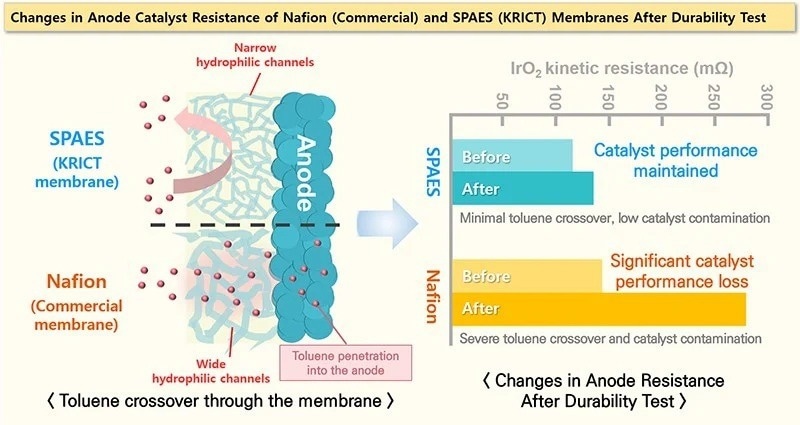Reviewed by Lexie CornerMay 7 2025
A research team in Korea has achieved a significant breakthrough by developing a novel proton exchange membrane (PEM) that substantially improves the performance of electrochemical hydrogen storage systems.
 Changes in Anode Catalyst Resistance of Nation (Commercial) and SPAES (KRICT) Membranes After Durability Test. Image Credit: Korea Research Institute of Chemical Technology (KRICT)
Changes in Anode Catalyst Resistance of Nation (Commercial) and SPAES (KRICT) Membranes After Durability Test. Image Credit: Korea Research Institute of Chemical Technology (KRICT)
Dr. Soonyong So from the Korea Research Institute of Chemical Technology (KRICT) and Professor Sang-Young Lee of Yonsei University have engineered a next-generation PEM for electrochemical hydrogen storage based on liquid organic hydrogen carriers (LOHCs) like toluene.
The membrane uses a hydrocarbon-based polymer called SPAES (sulfonated poly(arylene ether sulfone)), which significantly improves performance over the widely used perfluorinated PEM, Nafion. The SPAES membrane reduces toluene permeability by over 60 % and increases the Faradaic efficiency of hydrogenation to 72.8 %.
LOHCs like toluene offer a promising alternative for hydrogen storage and transport, as they can be handled under more moderate conditions compared to compressed (over 100 bar) or cryogenic (-252.9 °C) hydrogen. However, one of the main challenges in these systems is the unwanted permeation of toluene across the membrane. This crossover not only lowers efficiency but also contaminates the oxygen evolution reaction (OER) catalyst at the anode.
To address this, the researchers engineered a SPAES membrane with narrow hydrophilic channels around 2.1 nm in size, which facilitate proton transport but restrict the diffusion of toluene molecules, reducing their permeability by a factor of 20.
As a result, toluene crossover was cut by 60 %, and Faradaic efficiency improved from 68.4 % (with Nafion) to 72.8 %. During 48-hour durability tests, the voltage degradation rate was reduced by 40 %, from 1270 mV/h (Nafion) to 728 mV/h (SPAES). The membrane also showed strong chemical and mechanical stability, with minimal structural changes over prolonged use.
The team expects this innovation to support the development of high-efficiency, standalone electrochemical hydrogen storage systems that could reach commercial viability by around 2030.
Dr. So emphasized that this work addresses key performance bottlenecks in membrane technology for hydrogen storage. KRICT President Youngkook Lee added that this advance has significant potential for application in clean energy systems such as hydrogen fuel cell vehicles and hydrogen power generation, further supporting the transition to a hydrogen economy.
The corresponding authors are Dr. So, Dr. Duk Man Yu (both from KRICT), and Professor Sang-Young Lee (Yonsei University). Chang Jin Lee (KRICT) is listed as the first author.
Journal Reference:
Jin Lee, C., et al. (2025) An efficient toluene barrier membrane for high-performance direct toluene hydrogenation via an electrochemical process. Journal of Materials Chemistry A. doi.org/10.1039/D4TA06773H